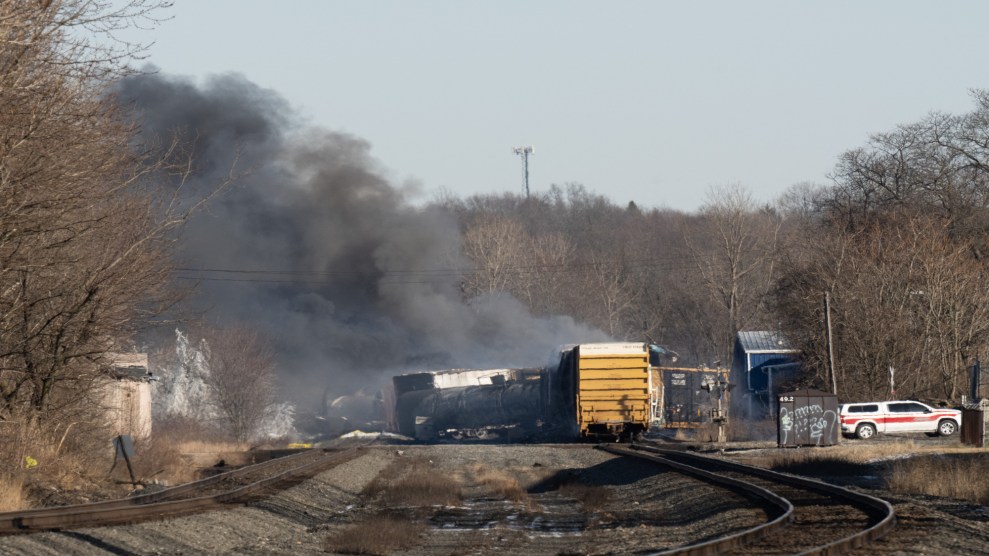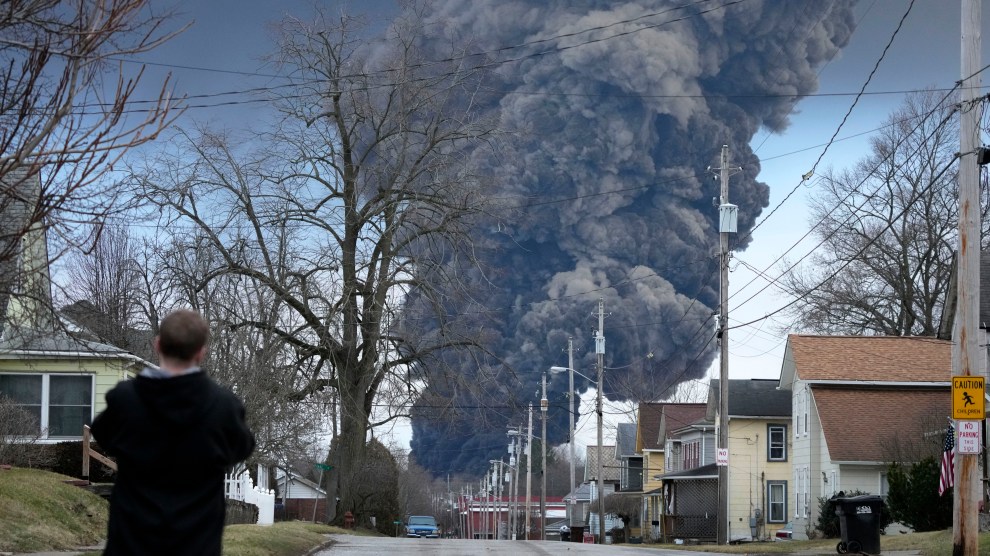
Smoke rises from a derailed cargo train in East Palestine, Ohio, on February 4, 2023. Dustin Franz/AFP/Getty
This story was originally published by Inside Climate News and is reproduced here as part of the Climate Desk collaboration.
The flames and deadly black smoke that billowed high over a small town on the Ohio and Pennsylvania border Monday were an acute reminder of a type of commonly used plastic with a particularly troublesome environmental and health record.
To prevent exploding rail cars, flying shrapnel and the uncontrolled release of killer gases, authorities vented vinyl chloride, a precursor of polyvinyl chloride, or PVC, and then burned the vinyl chloride in what officials described as a controlled manner, following Friday’s 50-car Norfolk Southern Railroad train derailment near East Palestine, Ohio, about 55 miles northwest of Pittsburgh. Local media showed dramatic video of an explosion and fire after Ohio Gov. Mike DeWine and Pennsylvania Gov. Josh Shapiro ordered evacuations.
On Tuesday, Ohio Director of Public Safety Andy Wilson said at a press conference that the fire was out and there had been no serious injuries, CBS Pittsburgh reported.
While the drama played out in Northern Appalachia, the story actually begins with an insatiable global demand for plastic, and what United Nations officials describe as a “triple planetary crisis of climate change, nature loss, and pollution.”
Vinyl chloride has been used to make polyvinyl chloride, used commercially to make such products as floor tiles, roofing and tents, for nearly 100 years. And there have been battles between industry and environmentalists over PVC for decades.
The versatile form of plastic that can be made to be rigid and durable for pipes, or soft and flexible for products such as intravenous bags and tubing, is no longer used as much as in the past in food packaging due to environmental health concerns. But it’s still a major building material for the construction industry, including siding and windows.
But one national environmental group, the Center for Biological Diversity, has been pressing the Environmental Protection Agency since 2014 to regulate PVC waste as hazardous. And health experts have also talked about having PVC declared a “persistent organic pollutant” under the 2001 United Nations Stockholm Convention on Persistent Organic Pollutants, a treaty that seeks to protect human health from chemicals that remain intact in the environment for long periods.
Those chemicals now litter the planet, accumulate in the fatty tissue of humans and wildlife, and have harmful impacts on human health and the environment. The US has not ratified the treaty but participates as an observer. “This derailment and explosion, while it’s not discharging PVC, it is indicative of the hazardous nature of this material,” said Emily Jeffers, an attorney at the Center for Biological Diversity. “As long as we continue to use PVC, we will continue to have accidents like this and it is entirely preventable.
“If we regulate PVC as the hazardous waste that it is, that could potentially force producers to develop materials with less toxic properties,” Jeffers added. “We lived without PVC before and I am pretty sure we can live without it again.”
Petrochemical facilities that make or use vinyl chloride or PVC are often found in communities of color in states like Louisiana, Texas and Kentucky that shoulder the health burdens from their polluting emissions.
EPA last May agreed to look into a 2014 petition from the Center for Biological Diversity to designate PVC a hazardous material, following a 2021 lawsuit seeking the same designation.
In January, the agency made a tentative decision denying the request, arguing that regulations would not have a meaningful impact while adding that the agency didn’t have the time or resources to create new PVC regulations. A public comment period closes Monday.
Like other chemicals, PVC has its own lobbying group in Washington. Called the Vinyl Institute, it touts the benefits of vinyl and the vinyl industry, which it said encompasses nearly 3,000 vinyl manufacturing facilities, more than 350,000 employees and an economic value of $54 billion.
PVC and vinyl are the third most used plastics in the world, according to the institute, which says on its website: “We are fiercely committed to achieving the policy agenda that helps the U.S. vinyl industry grow and create jobs.”
PVC has been used a lot, said Dr. Philip Landrigan, a pediatrician, epidemiologist and director of Boston College’s Global Public Health Program and Global Observatory on Planetary Health. But, he added, “it has problems at every stage” of its lifecycle, beginning with potential dangers to workers who make it.
Vinyl chloride is classified as a known human carcinogen. Researchers in the 1970s first linked its occupational exposure to a rare form of cancer—angiosarcoma of the liver—to rubber workers at a factory in the Rubbertown complex of chemical plants in Louisville, Kentucky. “There’s also some evidence it causes brain cancers,” he said.
PVC also contains a variety of chemical additives, such as phthalate plasticizers, some of which are blamed for disrupting the human endocrine system.
“There is good evidence” that toxic ingredients in PVC “can leach out of plastics products and get into drinking water or blood products,” said Landrigan, whose research has helped drive US public health policies on childhood lead exposure, pesticide exposure and the response to health impacts of 9/11 rescue workers in New York.
The industry has disputed such assertions. A 2017 report, for example, from the PVC Pipe Association maintains that PVC piping meets the “highest standards for quality and safety.”
Vinyl Institute spokeswoman Susan Wade said that PVC can and is being recycled, and according to the institute’s website, the industry has a goal of boosting the recycling of vinyl materials. “We know we have a good story to tell,” she said, pointing to a lifecycle carbon emissions study from McKinsey & Company that shows using PVC sewer pipes has less impact on the climate than using pipes made from concrete or iron.
But Jan Dell, a chemical engineer who founded and runs The Last Beach Cleanup, a nonprofit group that fights plastic waste, said that “PVC is by far the worst” of the plastics. “PVC wars go back years and years,” due to risks it has posed to the people and the environment, she said. Vinyl chloride itself, in factories and during transportation, as the trail derailment shows, “is gnarly,” she added.
EPA has also tracked only a “negligible” amount of PVC recycling, she said. The problem is its composition, she said, adding: “It’s toxic when it’s recycled with other stuff.”
The recycling woes are not unique to PVC. Dell worked with another environmental nonprofit, Beyond Plastics, to publish a report last year that found that less than 6 percent of all plastics are recycled in the United States.
Along with what Dell called a fairly successful push to get PVC out of food packaging, there have been battles over PVC in toys, particularly those that contained phthalates, which are now regulated by the Consumer Products Safety Commission.
But PVC plastic is still used widely to make gift cards—a problem called out in November by Dell and Beyond Plastics. “Unfortunately, many big brand companies are choosing to use PVC plastic to make their gift cards,” according to a Beyond Plastics holiday shopping alert in November. “Major retailers offer dozens of PVC gift cards for sale in their stores and informal surveys indicate that as much as 70 percent of the gift cards sold in stores are made from PVC plastic.”
Beyond Plastics called on all companies to commit to stop selling all PVC gift cards and switch to paper or electronic gift cards.
Eric J. Beckman, a University of Pittsburgh chemical engineering professor, said the starting raw materials for PVC are chlorine and ethylene, and both of those chemicals are very energy intensive to produce.
If a company tries to recycle PVC by melting it, “it tends to fall apart at the molecular level,” while generating unwanted byproducts such as hydrochloric acid, Beckman said. Companies that are attempting chemical recycling of plastics using a process such as pyrolysis try to remove any PVC from the waste stream “so as to not muck up their process,” he added. “The way to lessen the use of vinyl chloride is to find alternatives to PVC.”
Greenpeace has suggested some substitutes for PVC such as clay, glass, ceramics and linoleum. Others have suggested metal, fiber cement, and stucco, depending on the use, or other types of plastics.
Finding alternatives to PVC, Beckman said, “would be good on many levels.”
In Pittsburgh, Matt Mehalik, executive director of the Breathe Project coalition, said the derailment should serve as a further incentive to move beyond a petrochemical and fossil fuel economy in the region. He noted that a new Shell plastics manufacturing plant near Pittsburgh has been flaring excess emissions, among other incidents related to the region’s robust fracked fossil gas development.
“It is time to put an end to the health, safety, and economic risks to people in this region by shifting priorities away from building out this hazardous infrastructure to a healthier and more prosperous one.”
















